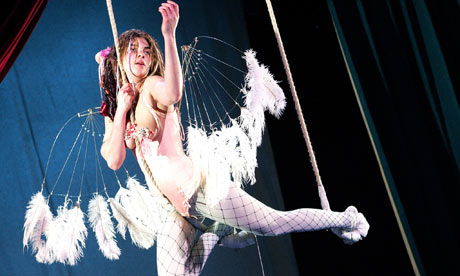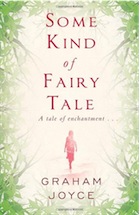From Angela Carter's Nights at the Circus to Alan Garner's The Owl Service, Graham Joyce chooses his favourite books in which the Fair Folk find themselves in fresh landscapes

Natalia Tena playing Fevvers in an adaptation of Angela Carter's Nights At The Circus Photograph: Tristram Kenton
 I'm very careful to avoid the "F" word. They don't like it. And anyway, I've stepped away from the obvious "retelling of fairytale" candidates. Recasting fairytales has become a publishing sub-genre in itself, and has been done both well and to the point of entropy. More interesting are those works where the structures of fairytales are abandoned but the world of "fairy" is imported as a delicate spice. In these fictions, magical and impossible content tends to be offered in a more naturalistic mode of storytelling. The effect for the reader is that of riding a shuttle between natural scepticism and open credulity. If there were a film paradigm it would start with Pan's Labyrinth. All of these authors are rule-breakers. I'd call them "fantasists" except that it's a word with an unstable currency; but a sense of awe and dislocation is upheld here, and a new way of knowing is always the prize
I'm very careful to avoid the "F" word. They don't like it. And anyway, I've stepped away from the obvious "retelling of fairytale" candidates. Recasting fairytales has become a publishing sub-genre in itself, and has been done both well and to the point of entropy. More interesting are those works where the structures of fairytales are abandoned but the world of "fairy" is imported as a delicate spice. In these fictions, magical and impossible content tends to be offered in a more naturalistic mode of storytelling. The effect for the reader is that of riding a shuttle between natural scepticism and open credulity. If there were a film paradigm it would start with Pan's Labyrinth. All of these authors are rule-breakers. I'd call them "fantasists" except that it's a word with an unstable currency; but a sense of awe and dislocation is upheld here, and a new way of knowing is always the prize1. The Djinn in the Nightingale's Eye by AS Byatt
Stuffed with marvels. Byatt doesn't re-tell fairytales, she creates her own and endows them with intelligent intention and original power. The heroine of the title story, Dr Gillian Perholt, is a scholar and a decoder of stories, and the narrative nests inside that detail. But it's not all cerebral fun. This story has a very large genie endowed with impressive and stinky genitals.2. The Faery Handbag by Kelly Link
To be found in the collection Pretty Monsters. Throw away everything you think you know about short stories and read Kelly Link: her stories get bigger each time you read them. You think you know what's in the bag, but you don't. The rhythms of Link's storytelling evoke some very old cadence patterns, but always operate in a modern idiom. I don't always know what her stories mean, but I always know that they are a delight.3. The Stolen Child by Keith Donohue
Inspired by Yeats's poem about the legend of the changelings, The Stolen Child also owes a debt to JM Barrie's Peter Pan, another fairy story that was not about fairies at all but about the loss of imagination and about growing up. On the surface, a clever novel about some rather degenerate Fair Folk. But while our backs are turned the author performs a switch and delivers a luminous novel about our humanity.4. Nights at the Circus by Angela Carter
Her collection The Bloody Chamber might be more obvious but some of those stories come under the re-telling category. Nights at the Circus is more anarchic and the chief protagonist is a peroxide blonde with wings called Fevvers, who was hatched from an egg laid by unknown parents. Yes, her wings are a metaphor but yes, her wings are real. Another landmark novel shunned by the Man Booker judges because it lacked, well, gravity. Many traditional fairytales are invoked and overturned throughout the novel.5. Shod by Mark Goodwin
The wildly inventive Midlands landscape poet won prizes for this brilliant collection. Goodwin experiments with ambient sound or acoustic context for recording his poems, many of which reference fairytales, or furry tales as the poet calls them.6. The Girl with Glass Feet by Ali Shaw
This is a novel that draws on the great tradition of European fairytales but which offers us a shimmering romance for our modern world. A luminous work, about a girl's transformation into glass.7. The Owl Service by Alan Garner
Garner is one of the very greatest fantasy writers in the English language, though I admit that the categorisations of his work as "Children's" or "Fantasy" are meaningless. The Owl Service is set in Wales, and uses as its basis a story from the mediaeval Welsh epic, the Mabinogion. Published in 1967, in 2007 The Owl Service was selected by judges of the Carnegie Medal for children's literature as one of the 10 most important children's novels of the past 70 years. Really, I could pick anything by this writer.
8. Briar Rose by Jane Yolen
This is a young adult novel, but nevertheless, the book won the annual Mythopoeic Society Award for Adult Literature in 1993. It combines the Sleeping Beauty story with the Holocaust and themes of homosexuality. That's right. Got it banned somewhere in the American Midwest. Constantly surprises as the standard images of the tale of Sleeping Beauty dissolve into the realities of life under the Nazis.9. Winter Journey by Joel Lane
A clever reversal of the feral-child story, first published in Black Static magazine, a terrific venue for this kind of writing. Joel Lane is another gem of a short-storyist. The narrator pursues some kind of fox-being, a creature that possesses one person after another, always travelling.






